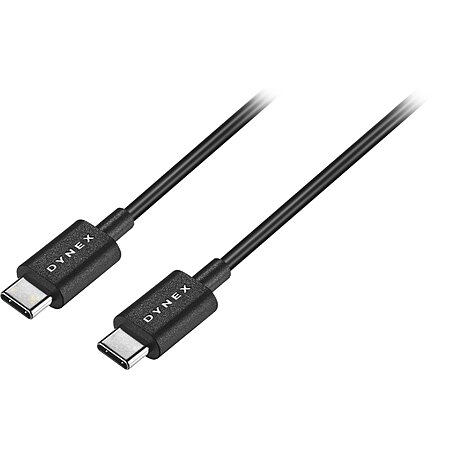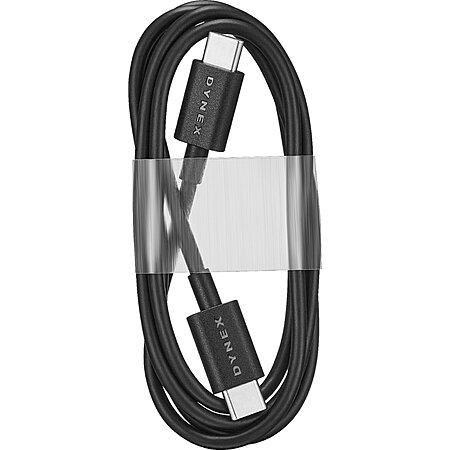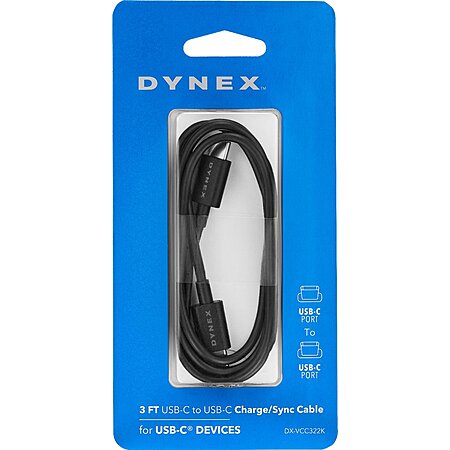expiredbw03 posted Mar 14, 2023 12:47 AM
Item 1 of 4
Item 1 of 4
expiredbw03 posted Mar 14, 2023 12:47 AM
3' Dynex USB Type C-to-USB Type C Charge-and-Sync Cable (Black)
& More + Free S&H$3.00
$6.99
57% offBest Buy
Visit Best BuyGood Deal
Bad Deal
Save
Share








Leave a Comment
Top Comments
The key value of interest for USB-C cables is the current (amps) ratings. This will affect the power rating (watts) based upon the capability of the charger and the device being charged.
The default current rating for USB-C to USB-C cables is 3 Amps. Contrast this with, for example, USB-A to USB-C cables which are normally to be limited to 1.5 A.
By comparison,older USB-A typically maxed out at 2.4A, with many common Qualcomm quick charging standards maxing out at 2A. This is the reason USB-A to USB-C must signal a device to attempt to draw no more than 1.5A lest it attempt to draw 3A from a device only capable of 2A.
Now connecting a 3A rated USB-C cable to an appropriate charger and device could supply anything from 15W for plenty of phones (3A at 5V) to 25W (25W Super Fast Charging which operates at 11V with 2.25A). Of course, the same cable between a laptop and its charger would easily deliver 60W (20V at 3A).
Using a USB-A to USB-C cable can be more challenging (read: harder to get a fast charge) since USB-A chargers don't always support the wider range of voltage standards common among USB-C devices (such as the power delivery modes which range up to 20V or the Programmable Power Supply PPS modes associated with Super Fast Charging). In the best case USB-A to USB-C might deliver up to 18W even when restricted to 1.5A using certain Qualcomm QuickCharge modes (still common among Samsung phones). In the worst case USB-C to USB-A will limit you to less than 8W of charging at the default 5V profile(!).
Good luck!
Jon
34 Comments
Sign up for a Slickdeals account to remove this ad.
E.g. charging phone is no brainer, but what about a car jump starter unit?
Just curious.
E.g. charging phone is no brainer, but what about a car jump starter unit?
Just curious.
My educated guess is that this should not go over 30 or 45 watts considering how thin the cables are.
Sign up for a Slickdeals account to remove this ad.
Our community has rated this post as helpful. If you agree, why not thank pr1nyc1
My educated guess is that this should not go over 30 or 45 watts considering how thin the cables are.
It is recommended to use the smallest possible wire gauges that meet the cable assembly electrical and mechanical requirements. To maximize cable flexibility, all wires should be stranded and the cable outer diameter should be minimized as much as possible.
A typical USB Full-Featured Type-C cable outer diameter may range from 4 mm to 6 mm while a typical USB 2.0 Type-C cable outer diameter may range from 2 mm to 4 mm. A typical USB Type-C to USB 3.1 legacy cable outer diameter may range from 3 mm to 5 mm.
TL;DR - Thickness (outer diameter) doesn't necessarily translate to capacity/performance. The gauge of the conductor (wire) inside the shielding is what determines that. Go by the rating, if you can find it.
"USB-C to USB-C $3.49 (2-pack)"
Is actually USB-A to USB-C.
Post needs fixed.
E.g. charging phone is no brainer, but what about a car jump starter unit?
Just curious.
A car jump starter recharges like any other device.
dynex is Best buy's generic brand. Best buy isn't going to make a non compliant cable.
and it's only 3ft. 60w is easy to hit.
Sign up for a Slickdeals account to remove this ad.
Leave a Comment